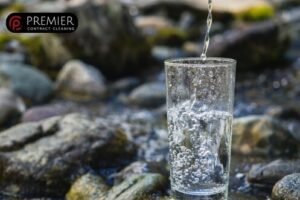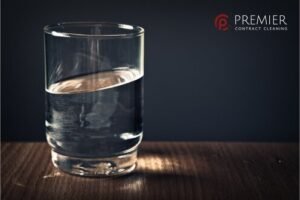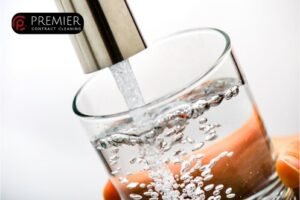Cleaning a bedroom wall is simpler than you think. Start by dusting the surface. Next, use a mild cleaner with a soft cloth. Walls can accumulate dust, stains, and marks over time. A clean wall brightens your room and enhances its overall appearance. Regular cleaning helps maintain the wall's condition and prevents long-term damage. Different […]
How is Water Cleaned for Drinking Ireland: A Complete Guide
In Ireland, water is cleaned through a multi-step process to ensure safety. This involves removing impurities and adding essential treatments.
Clean drinking water is vital for health. In Ireland, the government and water authorities work tirelessly to provide safe water. The cleaning process starts at the source, whether it's a river, lake, or reservoir. Water undergoes filtration to remove large particles.
Then, it's treated with chemicals to kill harmful bacteria and viruses. Finally, it goes through additional filters to remove any remaining impurities. This ensures that by the time it reaches your tap, the water is clean and safe to drink. Understanding this process helps us appreciate the effort behind every glass of water.
Water Sources
In Ireland, ensuring access to clean drinking water involves various methods and sources. Understanding these water sources is key to knowing how water is purified. Water for drinking in Ireland mainly comes from two sources: surface water and groundwater. Each source has its unique characteristics and methods for purification.

Surface Water
Surface water is one of the primary sources of drinking water in Ireland. It includes rivers, lakes, and reservoirs. These bodies of water are exposed to the environment and can be contaminated by various pollutants. Cleaning this water involves several steps to ensure it is safe to drink.
Here are some key aspects of surface water:
- Collection: Water is collected from rivers, lakes, and reservoirs. This is done through a network of pipes and channels.
- Screening: Large debris and contaminants are removed using screens. This prevents clogging and protects the treatment equipment.
- Coagulation and Flocculation: Chemicals are added to the water to bind small particles together. This forms larger particles called flocs, which are easier to remove.
- Filtration: Water passes through filters made of sand, gravel, and charcoal. This removes smaller particles and impurities.
- Disinfection: Chlorine or other disinfectants are added to kill harmful microorganisms. This ensures the water is safe to drink.
Surface water treatment is vital because these sources are more prone to contamination. The treatment process makes sure that any pollutants are removed, providing clean and safe drinking water.
To Get The Best Cleaning Services In Ireland - Click Here
Groundwater
Groundwater is another significant source of drinking water in Ireland. It is found in underground aquifers, which are layers of water-bearing rock or sediment. Groundwater is generally cleaner than surface water because it is filtered naturally through soil and rock.
Key aspects of groundwater include:
- Extraction: Water is extracted from aquifers using wells and pumps. These are installed to reach the groundwater and bring it to the surface.
- Natural Filtration: As water moves through soil and rock, it undergoes natural filtration. This removes many impurities and contaminants.
- Minimal Treatment: Because groundwater is naturally filtered, it requires less treatment than surface water. Often, disinfection is the primary treatment step needed.
- Protection: Protecting groundwater sources is crucial. This involves preventing contamination from agricultural runoff, industrial waste, and other pollutants.
Groundwater is a reliable source of drinking water, especially in rural areas. It provides a consistent supply of clean water, with minimal treatment required. However, it is essential to monitor and protect these sources to maintain their quality.
Water Treatment Process
In Ireland, ensuring clean drinking water is crucial for public health. The water treatment process involves several steps to remove impurities and make water safe to drink. This process is thorough and involves both pre-treatment and primary treatment stages.
Pre-treatment
Pre-treatment is the initial stage in the water treatment process. It involves several steps to prepare the water for further treatment:
- Screening: Large debris like leaves and twigs are removed using screens.
- Aeration: This step adds air to the water, which helps to remove gases such as carbon dioxide and hydrogen sulfide.
- Pre-Chlorination: Chlorine is added to control algae and bacteria growth.
The pre-treatment phase ensures that large particles and some organic materials are removed early. This makes the subsequent treatment stages more effective. Let's look at the steps involved in a bit more detail:
| Step | Purpose |
| Screening | Removes large debris to protect equipment. |
| Aeration | Removes dissolved gases and oxidizes iron and manganese. |
| Pre-Chlorination | Limits algae and bacteria growth. |
Primary Treatment
Primary treatment focuses on removing suspended solids and organic matter from the water. This stage includes:
- Coagulation: Chemicals like alum are added to the water. They help particles clump together.
- Flocculation: The water is gently stirred to form larger clumps called flocs.
- Settling: The water is left undisturbed in large tanks. The flocs settle at the bottom.
The primary treatment is vital as it removes a significant amount of impurities. By coagulating and flocculating particles, the water becomes much clearer. Let's examine the steps in more detail:
- Coagulation: This step neutralizes the charge of particles, making them stick together.
- Flocculation: Gentle mixing helps form larger, more settleable particles.
- Settling: Gravity helps these large particles settle, leaving clearer water on top.
Primary treatment significantly improves water quality before it moves to secondary and tertiary treatments. This process ensures that harmful substances are effectively reduced, making the water safe for consumption.
Filtration Methods
In Ireland, ensuring clean drinking water is a top priority. Filtration methods play a crucial role in this process. By using advanced techniques, water is purified to meet high safety standards. Let's dive into two key filtration methods used in Ireland: sand filtration and membrane filtration.
Sand Filtration
Sand filtration is one of the oldest methods for purifying water. This technique uses layers of sand to remove impurities from the water. The process is straightforward but highly effective. Here's how it works:
- Water passes through a layer of fine sand.
- Particles and contaminants get trapped in the sand.
- Clean water flows out the other side.
There are several benefits to sand filtration:
- Cost-effective: Sand is cheap and widely available.
- Low maintenance: Requires minimal upkeep.
- Efficient: Removes large particles and some bacteria.
Sand filters can be used in different setups. Here’s a simple table to illustrate:
| Type | Description |
| Slow Sand Filter | Water passes slowly through the sand, ideal for small communities. |
| Rapid Sand Filter | Water flows quickly, suitable for larger populations. |
In Ireland, sand filtration is a reliable method to ensure clean drinking water. It is often used in combination with other filtration methods for best results.
To Get The Best Cleaning Services In Ireland - Click Here
Membrane Filtration
Membrane filtration is a modern technique used in water treatment. This method uses a thin membrane to filter out contaminants. Here’s how it works:
- Water is pushed through a membrane.
- Contaminants are trapped by the membrane.
- Filtered water comes out the other side.
Membrane filtration offers several advantages:
- High precision: Removes very small particles and bacteria.
- Versatile: Can be used for various water sources.
- Efficient: Provides high-quality water.
There are different types of membrane filtration systems. Here’s a brief overview:
| Type | Description |
| Microfiltration | Removes particles larger than 0.1 microns. |
| Ultrafiltration | Filters out particles larger than 0.01 microns. |
| Nanofiltration | Targets particles larger than 0.001 microns. |
| Reverse Osmosis | Removes the smallest particles, including dissolved salts. |
In Ireland, membrane filtration is used in advanced water treatment facilities. This ensures the highest level of water purity. Combining membrane filtration with other methods provides safe and clean drinking water for everyone.

Disinfection Techniques
Water is essential for life, and ensuring it is clean and safe to drink is vital. In Ireland, water undergoes several treatments to make it fit for consumption. One of the key steps in this process is disinfection, which eliminates harmful microorganisms. Disinfection techniques ensure the water is free from bacteria, viruses, and parasites, making it safe for everyone. Two common methods used in Ireland are chlorination and UV treatment.
Chlorination
Chlorination is a widely used method to disinfect water. It involves adding chlorine or chlorine compounds to the water to kill bacteria, viruses, and other microorganisms. Chlorine is effective due to its strong oxidizing properties.
Here are some key points about chlorination:
- Cost-Effective: Chlorine is relatively inexpensive and easy to use.
- Residual Protection: Chlorine provides ongoing protection as it remains in the water, preventing recontamination.
- Proven Effectiveness: Chlorine has been used for over a century and has a track record of success in disinfecting water.
Despite its benefits, chlorination has some drawbacks:
- Taste and Odor: Chlorine can impart a noticeable taste and odor to water.
- Chemical Byproducts: Chlorination can produce byproducts like trihalomethanes (THMs), which may pose health risks.
- Sensitive Populations: Some individuals may be sensitive to chlorine and its byproducts.
Here's a simple table summarizing the pros and cons of chlorination:
| Pros | Cons |
| Cost-effective | Taste and odor issues |
| Residual protection | Formation of byproducts |
| Proven effectiveness | Potential sensitivity issues |
Uv Treatment
UV treatment is another effective method to disinfect water. It uses ultraviolet (UV) light to kill or inactivate microorganisms. This method is gaining popularity due to its efficiency and safety.
Key advantages of UV treatment include:
- Chemical-Free: UV treatment does not use chemicals, making it a safer option for people and the environment.
- No Taste or Odor: Since it doesn't involve chemicals, UV treatment does not alter the taste or smell of water.
- Effective Against a Wide Range of Microorganisms: UV light can effectively target bacteria, viruses, and protozoa.
Despite its benefits, UV treatment has some limitations:
- No Residual Protection: Unlike chlorination, UV treatment does not provide ongoing protection after treatment.
- Energy-Dependent: UV systems require a consistent power supply to function effectively.
- Water Clarity: The effectiveness of UV treatment can be reduced if the water is not clear.
Below is a table summarizing the pros and cons of UV treatment:
| Pros | Cons |
| Chemical-free | No residual protection |
| No taste or odor | Energy-dependent |
| Effective against various microorganisms | Reduced effectiveness in unclear water |
Regulatory Standards
Water is a vital resource. Clean drinking water is essential for a healthy life. In Ireland, ensuring water quality involves strict regulatory standards. These standards help in maintaining the safety and cleanliness of drinking water. Both Irish and European Union regulations play a critical role in this process. Understanding these standards can help appreciate the efforts behind providing safe drinking water in Ireland.
Irish Water Guidelines
Irish Water is responsible for providing safe and clean drinking water. They follow specific guidelines to ensure water quality. These guidelines are based on scientific research and best practices. Key aspects of these guidelines include:
- Regular testing of water sources
- Monitoring of water treatment processes
- Ensuring proper disinfection methods
- Maintaining infrastructure for water distribution
Regular testing is crucial. It helps identify contaminants like bacteria, viruses, and chemicals. Irish Water conducts tests at various stages of water treatment. They ensure that the water meets the required safety standards. Disinfection is another important aspect. Chlorine is commonly used to kill harmful microorganisms. Maintaining infrastructure ensures that clean water reaches every household without contamination.
Irish Water also provides guidelines for the public. These guidelines include:
- Boiling water during contamination alerts
- Using certified water filters
- Reporting any water quality issues
These measures help in maintaining the overall quality of drinking water. Irish Water's commitment to these guidelines ensures that residents have access to safe and clean drinking water.
To Get The Best Cleaning Services In Ireland - Click Here
Eu Regulations
The European Union sets high standards for drinking water quality. These regulations are designed to protect public health. The Drinking Water Directive is the main regulation guiding water quality in EU countries. Key components of this directive include:
- Setting maximum limits for contaminants
- Regular monitoring and reporting
- Implementing corrective actions when standards are not met
The directive sets limits for various contaminants such as:
| Contaminant | Maximum Limit (mg/L) |
| Nitrate | 50 |
| Lead | 0.01 |
| Chlorine | 0.5 |
Regular monitoring ensures that water suppliers comply with these limits. Reports are submitted to the European Commission. If any water supplier fails to meet the standards, corrective actions are mandated. These actions can include improving treatment processes or upgrading infrastructure.
EU regulations also emphasize transparency. Water suppliers must inform the public about water quality. They must provide information on the measures taken to ensure safety. This transparency helps build trust and ensures that residents are well-informed about their drinking water quality.
Monitoring Water Quality
Ensuring clean drinking water is vital for public health in Ireland. Monitoring water quality is a crucial step in making sure the water we consume is safe. This process involves various methods and procedures to detect and remove contaminants. It safeguards the health of the community and maintains the trust of the public in their water supply. Let's explore how water quality is monitored in Ireland through specific testing procedures and stringent quality assurance measures.
Testing Procedures
Testing water quality involves several steps to detect any contaminants that might be harmful. These procedures are carried out regularly to ensure the water remains safe for consumption. Here are some key steps involved:
- Sampling: Water samples are collected from different sources like rivers, lakes, and reservoirs. These samples represent the water consumed in various regions.
- Physical Tests: These include checking the color, odor, and taste of the water. Any unusual physical properties may indicate contamination.
- Chemical Tests: These tests check for chemicals like chlorine, lead, and nitrates. High levels of chemicals can pose a risk to health.
- Biological Tests: These tests detect harmful microorganisms like bacteria, viruses, and parasites. These organisms can cause diseases if present in drinking water.
- Radiological Tests: These tests ensure the water does not contain harmful levels of radioactive substances.
In Ireland, the Environmental Protection Agency (EPA) sets standards for these tests. The results help in identifying any potential risks and taking necessary actions to treat the water. Regular monitoring and testing are essential to ensure the safety and quality of drinking water.
Quality Assurance
Quality assurance in water treatment ensures that the procedures and processes meet the set standards. In Ireland, several measures are taken to guarantee this:
| Measure | Description |
| Compliance Monitoring | Regular checks to ensure water meets quality standards. |
| Audits | Independent reviews of water treatment processes. |
| Certification | Plants and processes are certified to meet specific standards. |
| Public Reporting | Providing the public with information about water quality. |
Compliance monitoring involves regular checks and balances. These checks ensure that the water treatment facilities follow the regulations set by the EPA. Audits are conducted by independent bodies to provide an unbiased review of the processes. Certification ensures that the facilities and their processes meet required standards. Public reporting keeps the community informed about the quality of their water, helping to maintain public trust.
Ensuring the quality of drinking water is a continuous process. It involves regular testing, monitoring, and improvements. This ensures that the water remains safe and clean for everyone in Ireland.

Challenges In Water Treatment
Ensuring clean drinking water in Ireland presents multiple challenges. The process involves various stages to remove contaminants and make water safe for consumption. However, two significant hurdles in this process are pollution issues and infrastructure limitations. These challenges impact the efficiency and effectiveness of water treatment.
Pollution Issues
Water pollution is a significant challenge in Ireland's water treatment process. Various sources contribute to this problem:
- Agricultural runoff: Fertilizers and pesticides from farms can seep into rivers and lakes. These chemicals are harmful to human health.
- Industrial waste: Factories may release pollutants into nearby water bodies. These include heavy metals and toxic substances.
- Sewage and wastewater: Untreated or partially treated sewage can contaminate water sources. This introduces pathogens and nutrients that promote harmful algal blooms.
These pollutants make water treatment more complex and costly. The table below highlights some common pollutants and their impact on water quality:
| Pollutant | Source | Impact |
| Nitrates | Agricultural runoff | Can cause methemoglobinemia, or "blue baby syndrome" |
| Heavy Metals | Industrial waste | Can lead to poisoning and long-term health issues |
| Pathogens | Sewage | Can cause waterborne diseases |
Addressing these pollution issues requires stringent regulations and effective waste management practices. Reducing pollution at the source is crucial for maintaining clean drinking water.
Infrastructure Limitations
Another significant challenge in water treatment is infrastructure limitations. Many water treatment plants in Ireland are outdated and require upgrades. Several factors contribute to these limitations:
- Aging facilities: Many treatment plants were built decades ago and have not kept pace with modern demands and technologies.
- Limited capacity: Some plants cannot handle the increased volume of water needed for growing populations.
- Maintenance issues: Ongoing maintenance is essential, but often underfunded, leading to inefficiencies and breakdowns.
The table below shows the impact of infrastructure limitations:
| Issue | Impact |
| Aging facilities | Increased risk of contamination and reduced treatment efficiency |
| Limited capacity | Inability to meet demand during peak times |
| Maintenance issues | Frequent breakdowns and higher operational costs |
Upgrading infrastructure requires significant investment and planning. Modern technologies and efficient systems can improve water quality and ensure a reliable supply. Addressing these infrastructure challenges is vital for providing safe drinking water to all residents in Ireland.
To Get The Best Cleaning Services In Ireland - Click Here
Emerging Technologies
Water is essential for life, and ensuring its cleanliness for drinking in Ireland involves advanced technologies. Emerging technologies play a vital role in enhancing the purification process. These innovations help in removing pollutants and ensuring safe drinking water. Two notable technologies are advanced oxidation and nanotechnology.
Advanced Oxidation
Advanced oxidation processes (AOPs) are effective in breaking down contaminants in water. These processes use oxidants to remove pollutants at a molecular level. The main goal is to produce hydroxyl radicals, which are powerful oxidizing agents.
Here are key features of advanced oxidation:
- Hydroxyl Radicals: These radicals react with contaminants, breaking them down into harmless substances.
- Multiple Methods: AOPs include various methods like ozone, hydrogen peroxide, and UV light.
- Comprehensive Purification: AOPs can remove a wide range of pollutants, including organic and inorganic compounds.
Various combinations of AOPs are used:
| Method | Combination | Usage |
| Ozone | Ozone + UV | Disinfection and oxidation |
| Hydrogen Peroxide | H2O2 + UV | Degradation of pollutants |
| Photocatalysis | TiO2 + UV | Oxidation of organic compounds |
Advantages of advanced oxidation:
- Highly effective in removing contaminants
- Can treat a variety of pollutants
- Improves water quality significantly
Nanotechnology
Nanotechnology introduces innovative solutions for water purification. It involves using nanoparticles to filter and clean water. These particles are tiny, usually less than 100 nanometers in size.
Key aspects of nanotechnology in water treatment:
- Nanofilters: These filters can remove viruses, bacteria, and other small particles from water.
- High Surface Area: Nanoparticles have a large surface area, enhancing their ability to absorb contaminants.
- Efficiency: Nanotechnology can purify water more efficiently than traditional methods.
Types of nanotechnology applications:
| Application | Description | Benefits |
| Carbon Nanotubes | Small cylindrical structures | High filtration efficiency |
| Silver Nanoparticles | Used for antimicrobial properties | Removes harmful microorganisms |
| Nanoporous Membranes | Membranes with tiny pores | Selective filtration of pollutants |
Benefits of nanotechnology in water treatment:
- Removes even the smallest contaminants
- Reduces the need for chemical additives
- Provides sustainable and efficient solutions
Community Involvement
Clean drinking water is essential for healthy living. In Ireland, the process of cleaning water involves community involvement. This helps ensure that the water remains safe for everyone. The community plays a vital role in maintaining water quality. Public awareness and volunteer programs are key components of this effort.
Public Awareness
Raising public awareness about water cleanliness is crucial. People need to understand the importance of clean water. Awareness campaigns help educate the community. These campaigns focus on simple steps everyone can take to keep water clean.
Here are some key points covered in these campaigns:
- Proper disposal of waste
- Avoiding pollutants near water sources
- Reporting any water contamination
Schools and community centers often host workshops. These workshops teach children and adults about water safety. They include fun activities and informative sessions. This makes learning about water cleanliness enjoyable.
Additionally, local media plays a significant role. Newspapers, radio, and television broadcast information about water safety. Social media platforms also help spread awareness. Regular updates keep the community informed.
The government supports these initiatives. They provide resources and information. Public awareness is a continuous effort. It ensures that everyone understands their role in maintaining clean drinking water.

Volunteer Programs
Volunteer programs are another essential part of community involvement. These programs encourage people to take an active role. Volunteers help in various activities to keep water sources clean.
Here are some common volunteer activities:
- Cleaning local rivers and lakes
- Planting trees to prevent soil erosion
- Monitoring water quality
Volunteer programs often involve different groups. Schools, environmental organizations, and local businesses participate. This creates a sense of community and responsibility.
Training sessions are provided for volunteers. These sessions teach them how to handle different tasks. Volunteers learn to use tools and equipment safely. They also learn about the importance of their work.
Volunteer efforts are coordinated by local authorities. They ensure that the activities are effective. Regular reports are shared with the community. These reports show the progress and impact of volunteer programs.
Volunteer programs help build a strong community. They create awareness and encourage action. By working together, the community helps ensure clean drinking water for everyone.
To Get The Best Cleaning Services In Ireland - Click Here
Future Of Water Treatment
Water is vital for life. Ensuring clean drinking water is essential. In Ireland, water treatment is an important process. But what does the future hold? New methods and technologies are emerging. These aim to improve water quality and sustainability. Let's explore what lies ahead in the future of water treatment in Ireland.
Sustainability Practices
Sustainability is key in modern water treatment. Traditional methods can harm the environment. Sustainable practices seek to reduce this impact. These practices use fewer chemicals and less energy. They also aim to protect natural resources.
Some sustainable practices include:
- Rainwater Harvesting: Collecting rainwater for use. This reduces the demand on local water sources.
- Green Infrastructure: Using natural systems to manage water. Examples include wetlands and green roofs.
- Water Recycling: Treating wastewater for reuse. This helps conserve fresh water.
- Energy-efficient Equipment: Using technology that consumes less energy.
In Ireland, these practices are becoming more common. They offer a way to manage water resources responsibly. The goal is to balance human needs with environmental protection. This approach ensures that future generations have access to clean water.
Innovative Solutions
Innovation drives progress in water treatment. New technologies offer better and faster ways to purify water. These solutions are often more effective and efficient.
Some innovative solutions include:
- Advanced Filtration Systems: These systems remove contaminants more thoroughly. They use materials like graphene and carbon nanotubes.
- Ultraviolet (UV) Treatment: UV light kills bacteria and viruses. It is a chemical-free method of disinfection.
- Desalination: This process removes salt from seawater. It provides an alternative source of fresh water.
- Smart Water Networks: These use sensors and data analytics. They monitor water quality in real-time. They also detect leaks and other issues quickly.
In Ireland, these innovations are being adopted. They help ensure a reliable supply of clean water. They also support sustainable water management. The future of water treatment looks promising with these advancements.
Frequently Asked Questions
How Is Water Treated For Drinking In Ireland?
Water in Ireland is treated using filtration, disinfection, and chemical treatments. This process removes contaminants and ensures safety.
What Are The Steps In Water Purification?
Water purification involves screening, coagulation, sedimentation, filtration, and disinfection. Each step removes different impurities from the water.
Is Irish Tap Water Safe To Drink?
Yes, Irish tap water is safe to drink. It meets strict safety standards and is regularly tested for contaminants.
How Does Ireland Test Water Quality?
Ireland tests water quality through regular sampling and laboratory analysis. This checks for bacteria, chemicals, and other pollutants.
Conclusion
Ireland ensures safe drinking water through rigorous purification processes. These steps include filtration, disinfection, and frequent testing. Each step removes contaminants and ensures water quality. Clean water is vital for health. Understanding these processes helps appreciate the effort behind safe drinking water.
Everyone plays a part in maintaining water quality. Simple actions like reducing pollution help protect our water sources. By working together, we can keep Ireland's water clean and safe for all.
To Get The Best Cleaning Services In Ireland - Click Here

Catalin Fatul is the founder and expert behind Premier Contract Cleaning, dedicated to providing top-notch cleaning solutions and tips. With a passion for cleanliness and a commitment to quality, Catalin brings years of experience in the cleaning industry to help readers maintain pristine spaces. Whether it's offering the latest cleaning hacks or recommending the best products, Catalin's mission is to make cleaning efficient, effective, and enjoyable.
The golden rule of cleaning is simple: clean from top to bottom. This basic principle ensures that dirt and dust don't settle on already cleaned areas. Understanding this rule can transform your cleaning routine. It saves time and effort, making the process more efficient. Imagine tidying up a room only to find dust has settled […]
Some cleaning products can harm surfaces or your health. Knowing what to avoid is essential for safe cleaning. Cleaning is a routine task, but choosing the right supplies is crucial. Some products can damage surfaces or release harmful chemicals. This is especially important in homes with children or pets. For example, certain cleaners may harm […]
The 20 Minute Rule in cleaning is a simple strategy. It involves dedicating just 20 minutes to tidying up. This method is designed to make cleaning less overwhelming and more manageable. Cleaning can feel like a daunting task. Many people struggle to find time to keep their spaces tidy. The 20 Minute Rule breaks down […]


